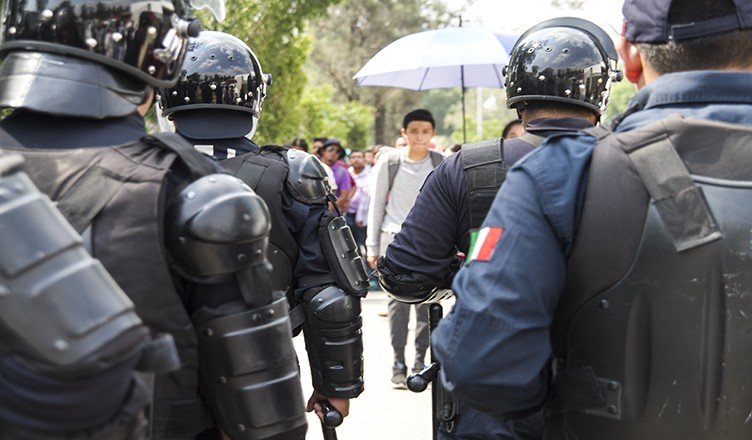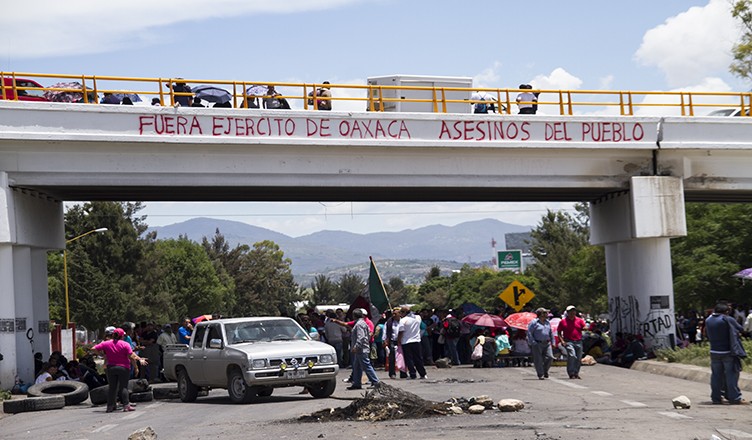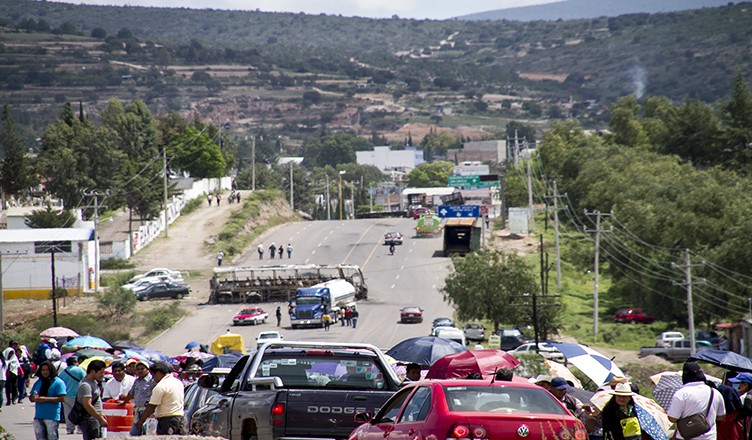Filed under: Mexico, Repression, Southern Mexico

By Renata Bessi and Santiago Navarro F.
From Avispa Midia
Translated by Scott Campbell
It has been more than a week since the massacre of June 19, perpetrated by the Mexican state, who gave the order to the Federal Police to retake control of this state. There is still no justice. The toll continues to climb, 12 deaths recorded so far, dozens disappeared and at least 100 wounded by firearms. On top of dealing with the aftermath of the deaths, now the relatives of the dead and wounded are being threatened so they don’t take any legal action. This was reported by lawyers advising the families.
“There is fear because there have already been threats directed towards the families and the prisoners who were arrested. They even arrested twenty people who were in the municipal cemetery digging a grave to bury a family member who passed away on June 18 due to causes unrelated to this situation. They tortured them during transport and they were held in the state police barracks for more than two days and in the end they released them and told them to go, that nothing had happened. Things are not so simple,” said Mariana Arrellanes, a lawyer with Section 22 (of the teachers union) in Oaxaca.
While preparing this report, a neighbor from Nochixtlán approached us and gave us a list of those wounded by weapons fire, she did not want to give her name for security reasons. “There are at least five with bullet wounds, but they don’t want to go to the hospital out of fear. Because family members are already getting threats for filing complaints,” she said.
Later, research for this report led to the collection of statements from some inhabitants of Nochixtlán, whose names are not mentioned for security reasons, who maintain that those “at the ISSSTE (health clinics for government employees) in Nochixtlán told them that they had to be operated on in the city hospital and if not, they would die.” The wounded rushed to the hospital but were received by the state prosecutor to take their statements. Four of them returned to Nochixtlán and only one was operated on.

Photo: Santiago Navarro F
Torture and irregularities
The lawyer states that the Federal Police performed acts of extreme torture on all those arrested in Nochixtlán and in the city of Oaxaca. For the first four detainees, there is not even a document stating that they were arrested, she says. “They just opened the doors and let them go because they were the most badly injured, they could not physically hide the kind of torture they were subjected to. They are willing to file formal complaints but there are also fears due to the threats, but we are not going to allow more impunity,” Arrellanes adds.
The lawyer discusses the irregularities in the investigations being carried out by the authorities. Bringing the prisoners before the appropriate authorities took more than 24 hours, for example. According to the new criminal justice system, immediately upon arrest they should have been brought before the appropriate authorities. “For us, they had been disappeared. In that moment, we filed a motion seeking protection from forced disappearance and a complaint seeking protective measures for them, to be presented alive in front of an official and for them to be released,” she adds.
Arrellanes is concerned with the chain of investigation. She notes that the autopsies and chain of custody have been irregular. “We have realized that there are irregularities in the compiling of the investigatory file. There is no chain of custody for the objects that were used, such as bullet casings. They haven’t safeguarded any of these things and this worries us because we don’t want history to repeat itself, where they take away a body with one gunshot wound and later two or three more appear. The chain of custody is not working,” the lawyer said.
Access denied to justice and healthcare
According to the lawyer, the Federal Judiciary suspended its work on the days of the incidents and during those moments “they denied us access to justice, because we tried to file an injunction against forced disappearance and there was no district judge.”
It was the same with access to healthcare. “The hospitals closed and that went for everybody. The Oaxaca Health Ministry will have to answer for the people who died due to lack of medical attention.”
Strategy of war
It is clear that the operation carried out in Oaxaca by the Federal Police was premeditated from the start and nothing was spontaneous. It is not news that the leadership of the army and federal police have received training in the United States in line with the Mérida Initiative agreements for the war against drug trafficking, the same ones who carried out the orders in the State of Oaxaca.
The first strategy deployed in this operation is one of the principles of US military doctrine, a media war, carried out through the manipulation of information in the media. In this case, they use this strategy to legitimize the Educational Reform and so justify the use of public force, and delegitimize the demands of the teachers.
In a second phase, this strategy of social control turned into psychological terrorism in Oaxaca. They took over the signal of the teachers’ radio station (Radio Plantón) and later that of Radio Universidad. Meanwhile, on social networks and in the corporate media, information circulated that “the Marines and the army were having confrontations with the teachers,” that “trucks with heavy artillery” were advancing on the city of Oaxaca. Before the federal police killed demonstrators, is was already on social networks that some demonstrators had “died in the confrontations” and they had been “infiltrated by teachers firing at the police.” However, in the images taken by various independent media outlets, one can see the police firing their weapons at people while the demonstrators take cover. The false alarms were immediately disproven by updates from independent media.
“It’s a dirty war where they are using terrorism to try to scare us. I can say that our young fallen were outflanked by the army. The death of each one of them is not by chance. Young people, 17, 19, 18, 25, and 32 years old. The youth have gained a strong consciousness through this struggle. There are young people today against schools bearing the name of Gabino Cué Monteagudo – governor of Oaxaca – because they don’t want the name of a murderer on their graduating class. Of course this is a media war using terrorism to scare us,” said Adriana Marcelina Linares Arrollo, a mother from Tamazulapan, Oaxaca.
The weapons didn’t appear out of nowhere and it was not a decision taken at the last minute. “They not only wanted to break up the demonstrations and blockades but wanted to generate terror so that the people would stop coming out into the streets to join this resistance. But the strategy has failed, now the people are angry and are ready for anything,” says a contributor to Radio Plantón who did not want to give his name for his own safety, as several members of that station have been threatened because they continue broadcasting.
“We demand the right to the truth. Who were those who gave the orders? Who allowed them to leave the barracks armed? Someone gave the order and that person is a high-ranking official. Because they didn’t pick them up passing by the store,” said the lawyer, Mariana Arrellanes.
The organizing of the people tends to aspire not to throwing out the governor, but going beyond that. “In Oaxaca there are experiences of self-government and the lessons from 2006 were precisely the experiences of the assemblies, but we have to be aware of opportunists and those seeking to hop on the struggle that today is not belongs to the teachers but to the people of Oaxaca. We have to create processes of self-government and to not take any more of these corrupt and murderous governments,” the lawyer adds.

Photo: Santiago Navarro F





